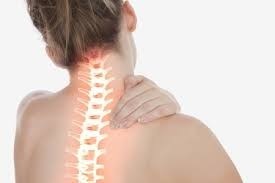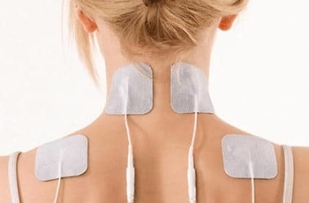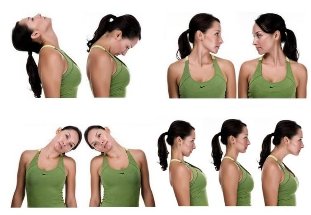Working in the office, "resting" in front of the television, lack of physical activity, unhealthy diet - the causes of a multitude of diseases that were particularly widespread at the end of the last century. One of them is osteochondrosis. More precisely, osteochondrosis of the cervical spine.
functions
Everyone has experienced the symptoms of osteochondrosis at least once. But if they seriously disrupt and even affect life and work, you can and should struggle with them. Contact your doctor if you have any concerns:

- Neck pain that extends to the back of the head, the eyes and ears, the shoulder girdle and does not go away even at night
- Pain in the arms (shoulder, forearm, hand) that worsens with the least amount of effort
- Difficulty moving hands, hands, fingers, decreased sensitivity and weakened muscle strength
- Neck muscle tension and cervical stiffness in the morning
- Sensation of "lulling" the throat in the morning
- Neck pain when bending and turning the head
- Numbness, burning, tingling sensation in the hands or feet
- recurring throbbing pain in the neck and back of the head
- Headache that starts in the back of the head and spreads to the crown of the head and temples
- Dizziness, darkening of the eyes, fainting when the head suddenly turns
- Tinnitus
- decreased visual acuity and hearing
- Numbness of the tongue
- pain in the area of the heart, the intensity of which depends on the position of the body and not due to nitroglycerin
- Overgrowth of the connective tissue - the "withers" - in the cervical spine is alleviated.
With degenerative changes in the spine (intervertebral discs are reduced, the annulus fibrosus loses its elasticity), the so-called radicular syndrome develops, and depending on the location of the changes, certain symptoms occur. The number of cervical roots (eight) is greater than the number of cervical vertebrae (seven). The first pair of cervical roots extend between the base of the skull and the first cervical vertebrae (C1), the second between the first and second vertebrae, and so on. Thus, each cervical nerve exits above its corresponding vertebra.
If the nerve root of the first cervical vertebra (C1) is affected, the sensitivity in the occipital area is impaired, the second (segment CI-II) has pain in the parietal and occipital area. The defeat of the nerve root (C3) in the area of the CII-III segment occurs rarely. In this case, there is pain and a decrease in sensitivity in the half of the neck where the spinal nerve is pinched, a decrease in tongue sensitivity and impairment of speech are possible.
Pain and decreased sensitivity in the shoulder girdle and collarbone, hypotension of the head and neck muscles (belt, trapezium, levator scapula) occur when the C4 nerve root is affected (segment CIII-IV). Difficulty breathing, hiccups, and pain in the heart area may also be associated with the C4 root because the phrenic nerve is present in it. But this is also a rather rare pathology.
Radicular syndrome at the level of the 5th vertebra (segment CIV-V) causes pain that extends to the shoulder girdle, the outer surface of the shoulder. The deltoid muscle weakens, the sensitivity in the outer surface of the shoulder is disturbed. The most common violations are pinching of the C6 and C7 roots (segments CV-VI and CVI-VII). In the first case, the pain radiates from the neck along the shoulder blade, forearm, the outer surface of the shoulder, the radial surface of the forearm to the thumb. The sensitivity is impaired not only in these areas, but also in the skin. In the second case, the pain spreads from the neck to the shoulder blade, forearm, back of the shoulder, the surface of the forearm to the back of the II-IV fingers of the hand. The skin in these areas also loses sensitivity.
When the C8 root is affected (segment CVII-TI), pain and sensory disturbances spread from the neck to the back of the shoulder along the ulnar edge of the forearm to the little finger. You may not feel pain in your little finger, but the muscles in that finger are weakened.
Description
Osteochondrosis is a degenerative-dystrophic lesion of the intervertebral discs in the spine. The cervical region is the most vulnerable part of the spine, as it has a special structure and suffers from a weak muscle corset in the neck area and from anatomically different structures of the cervical vertebrae that are very close to each other. Therefore, even with a light load on the neck, the vertebrae are displaced, which leads to compression of the blood vessels and nerves. This is very dangerous because it is in this section that the vertebral arteries pass through the holes in the transverse processes of the cervical vertebrae, which are involved in supplying blood to the brain. Any pinching of the vertebrae is therefore associated with the most serious consequences.
The compression of nerve roots and vessels in cervical osteochondrosis can lead to a displacement of the disc in the lateral and postero-lateral direction, a protrusion (the initial stage of the herniated disc, in which the integrity of the disc is not broken, but only in the spinal canalprotrudes) and lead to a herniated disc. directed inwards of the intervertebral canal.
Degenerative changes, in which bone growth occurs in the area of the spinal joints in cervical osteochondrosis, reduce the lumen of the intervertebral canal and compress the neurovascular formations passing there. The osteophytes formed on the sides of the vertebral bodies stimulate the muscles, the muscles tense and increase the pressure of the vertebrae against each other. At the same time, the height of the intervertebral disc decreases, which exacerbates the pathological process. Overgrown osteophytes, which are directed to the canal of the vertebral artery, compress it and cause cerebral circulation to fail even with a sharp turn of the head.
Even if there are no physiological changes in the cervical spine, prolonged tense posture can lead to pain and numbness.
Until recently, it was precisely the presence of cervical osteochondrosis that explained all tension headaches and dizziness.
Regarding meteorological and morning headaches, studies by foreign neurologists conducted in the 1980s showed that cervical osteochondrosis is not always the cause. They believe this is an example of replacing a clinical diagnosis with an X-ray diagnosis. A traditional medical mistake is overdiagnosis of osteochondrosis, which nowadays occurs even in adolescents. Often there is no connection between the findings on X-rays, MRI, CT and the mentioned clinical manifestations. Muscle tension headache, if it has a meteorological character and is observed in the morning hours, means neck pain and headache caused by intracranial venous congestion. This can easily be checked with a duplex scan. Wrong diagnosis - wrong treatment means the problem is getting worse.
Most often, after 35 years of age, a person begins to feel the manifestations of osteochondrosis, and the older they are, the more manifestations they have. In recent years, however, more and more people between the ages of 18 and 30 have been complaining of neck pain. The reasons are poor physical fitness, poor posture and curvature of the spine, flat feet, or excessive weight. Neck problems are most common in people who work a lot on computers or drive a car.
The main reasons for the early development of cervical osteochondrosis:
- hereditary (genetic) predisposition
- Metabolic disorders in the body, infections, poisoning
- overweight
- Malnutrition (lack of trace elements, vitamins and fluids)
- spinal injuries (bruises, fractures)
- poor posture, curvature of the spine
- instability of the spinal column segments
- flat feet
- unfavorable environmental conditions
- sedentary lifestyle
- heavy lifting
- work related to frequent changes in body position (turns, flexion and extension, jerks)
- prolonged uncomfortable posture while standing, sitting, lying down, lifting and carrying weights, during work that stresses the cervical spine and the spine as a whole
- excessive physical activity with an undeveloped musculoskeletal system
- nervous strain, stress
- hypothermia
- Use the wrong pillow when you sleep.
First aid

If you can't stand the pain, take a pain reliever from your medicine cabinet. If these drugs don't help, you'll need to use nonsteroidal anti-inflammatory drugs. However, these drugs have a negative effect on the gastrointestinal tract. They can therefore only be used as an emergency measure without consulting a doctor. Then you should ask a specialist for advice. You can reduce the intensity of the pain by using anti-inflammatory pain relieving ointments. If edema has formed in the area of inflammation, you can take diuretics or herbal infusions for 3-4 days, if there are no contraindications. You can wear pepper patches during the day, it also has a distracting effect, but it is useless at night. If problems with the neck cause numbness or pain in the arm, then there is no point in smearing an ointment on it. The medicine should be applied to the affected area - the neck.
If you use a special collar to hold your neck in place, don't wear it for long. When they are motionless, the neck muscles weaken and atrophy, and it even becomes difficult for them to keep their head on their shoulders.
Physiotherapy should not be performed during an exacerbation - you cannot begin it until the exacerbation has been removed.
diagnosis

The diagnosis is made using x-rays, computed tomography and magnetic resonance tomography. To check the condition of the cervical vessels, Doppler ultrasound or duplex scan is prescribed.
Treatment
Therapy for cervical osteochondrosis should be as comprehensive as possible and should include both drug and non-drug therapies and to prevent possible complications.
Medical treatment consists of prescribing drugs to relieve pain and inflammation, as well as drugs to improve brain circulation. In addition, in the case of pathological muscle tension, it is recommended to take drugs for relaxation, as well as vitamins in a therapeutic dose, calcium, phosphorus, magnesium and manganese preparations.
Conventional drugs, so-called chondroprotectors, which promise to restore the intervertebral disc tissue, are useless according to doctors. There is no clinical evidence of its effectiveness.
Physiotherapy plays an important role in the treatment of cervical osteochondrosis - electrophoresis, magnetotherapy, water procedures (various therapeutic baths, showers), paraffin applications. . .
Alternative therapy methods are also widely used - reflexology, manual therapy, massage, hirudotherapy, apitherapy, osteopathy. However, the most important thing for the treatment and prevention of osteochondrosis are therapeutic exercises.
lifestyle
In order not to interfere with the problems associated with cervical osteochondrosis, you should remember the causes of its development and the occurrence of complications, and if possible, prevent them. Since the main reason for the development of cervical osteochondrosis is a sedentary lifestyle and an unphysiological position of the body in tension, it is necessary to do daily exercises for the neck, including those in morning exercises or at work. At the same time, remember that doctors do not recommend performing circular rotational movements of the head. Its implementation is fraught with an injury to the neck.

Sitting and standing exercises
- Place your palm on your forehead, press your forehead against your palm, and contract your neck muscles. In this case, the palm must withstand the pressure of the forehead for 7-10 seconds. Do the exercise 3-4 times. Repeat the same exercise 3-4 times with the palm of your hand on the back of your head.
- Place your left palm on your left temple and press it against your palm, contracting your neck muscles for 7-10 seconds. Do the exercise 3-4 times. Repeat the same exercise, pressing down on the right palm with your right temple.
- The two exercises above can be done differently: Place your forehead against a wall and press on it, straining your neck muscles. Then press the back of the head against the wall, then the left and then the right half of the head.
- Tilt your head back a little. Overcome the resistance of the tense neck muscles and gradually lower it. Finish the exercise by pressing your chin against the jugular fossa. Repeat this exercise 5-6 times.
- Stand up straight with your shoulders open. Slowly turn your head right and then left 5-6 times.
- Lower your chin to your neck and slowly turn your head in this position: 5-6 times to the right, then to the left.
- Tilt your head back a little. Try grabbing your right shoulder with your right ear, and then your left shoulder with your left ear. Repeat each exercise five times.
- Pinch your fingers at the back of your head, bring your elbows together, and rest your chin on folded forearms. Grasp your fingers so the edge of your palm is against the back of your head and raise your forearms as high as possible. Stay in this position without straining yourself for 10-15 seconds.

Lying exercises:
- Lie on your back, straighten your legs and stretch your arms along your body. Bend your knees and grasp them with your hands, pulling them to your stomach, in this position lift your head and touch your knees with your forehead. Slowly straighten your legs, raise your head. Do this exercise 4-5 times.
- Bend your knees and grab the edge of the sofa or headboard with your hands. Slowly raise your torso and grasp your hands with your feet. Do the exercise 4-5 times.
- Lie on your stomach with your legs straight. Hands are on the body. Lean on your legs, stomach, and lower body, and raise your head and shoulders. Do this exercise 4-5 times.
- Lie straight with your arms on your side. Lift it slightly off the floor, turn your torso to the left and take out your left palm with your right hand. Do the same with your left hand reaching your right palm. Do this exercise 4-5 times.
- Lie on your stomach with your arms outstretched, palms up and chin level with your torso. Relax and slowly turn your head to the right - to the starting position - to the left. Try turning your head so that your ear is touching the floor. Do this exercise 8-10 times.
- Lie on your stomach, rest your chin on your palms, and relax your neck muscles. Turn your head right and left and try to touch the floor with your ear. Do this exercise 8-10 times.
Regular exercise helps to relieve muscle tension, improve blood flow in the collar area and improve the mobility of the vertebrae themselves. However, as you do the exercises, monitor your emotions - do not increase the intensity of movements and tension when pain occurs. In such cases, you should train with great care and not for long.
Prevention
To prevent osteochondrosis, doctors recommend regular visits to an orthopedic surgeon from an early age at school and, if necessary, correcting curvatures of the spine and postural disorders. Form a muscular corset - play sports, especially swimming. Eat foods that provide the body with calcium and magnesium (fish and seafood, spinach, beans, nuts, seeds, peas, whole grain breads, dairy products, cheese) and vitamins. Avoid the accumulation of excess weight. Follow doctors' recommendations when using a computer. Don't carry bags by hanging them on your shoulder.
































